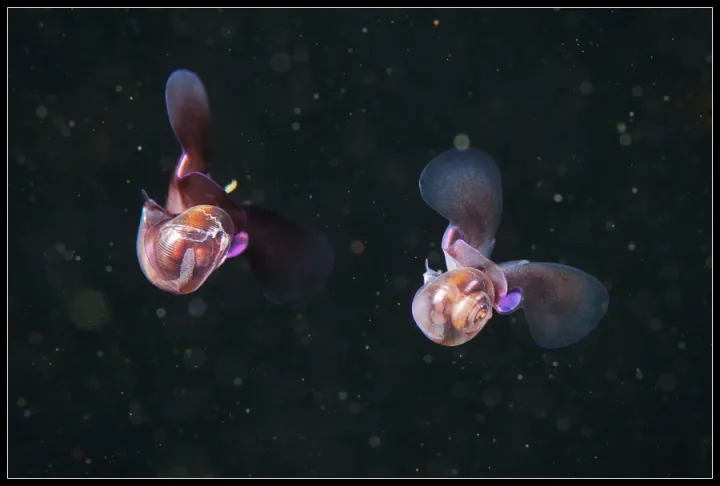Angels of the Sea

Tis the season when angels grace mantelpieces, treetops, and front stoops. Perhaps then, the timing also warrants an introduction to the fluttering angel that lives in the sea. Sea angels are a group of gelatinous sea snails within the larger mollusk division that have earned a heavenly distinction despite their modest existence as a snail. Scientists refer to them collectively as Gymnosomes and the most common species are Clione limacina and Clione antarctica. Even though they grow to be only one and a half to about three inches long (4-7 cm), ocean explorers delight at their sight because of their beauty and cool anatomy. For those not as familiar with the angels of the sea, take a look below to find out what makes sea angels a snail worthy of distinction.
Beauty
Graceful swimmers, sea angels are beautiful to watch. Their wing-like fins propel them in a manner reminiscent of flying, which is partially why they are commonly known as sea angels. Sea angels are also fairly translucent, creating an almost ethereal illusion. The translucent skin allows for view of their internal organs, like their gonads, which are a pretty pink and orange hue.
Ravenous Eaters
Though their name implies an angelic nature, sea angels are, in fact, predators with quite a bite. In a sick twist, their preferred food is one of their close relatives, the shelled sea snails commonly known as sea butterflies. Some species are ambush predators, lying in wait until prey passes by, while other species actively attack. Once the sea angel gets hold of its prey, it uses two specialized eating appendages known as buccal cones to extract sea butterflies completely out of their shells. The buccal cones have numerous hooks and a toothed radula that enable a quick and efficient meal. From capture to consumption, it can take as little as two minutes!
A Sour Taste
Even predators need tactics to avoid becoming lunch, and sea angels in Antarctic waters have evolved to produce a chemical compound that deters fish. This is a pretty extraordinary feat for a mollusk—it is the only example in which a chemical defense is produced by the mollusk and not absorbed from a food source. The tiny crustacean called an amphipod even seeks out sea angels to benefit from their chemical protection by hitching rides on their backs.
Gender Switch
Sea angels have the remarkable ability to switch genders. Specifically, they are protandrous hermaphrodites, which means they start out male and turn female throughout the course of their lives. Catching the mating between two sea angels is quite the sight. The two swirl, locked together for up to four hours, almost as if they were partners in dance.
Metamorphosis
As adults, sea angels are soft bodies creatures, but when they are initially born, they reside within a shell. As they age, they undergo a metamorphosis, much like a caterpillar transforms into a butterfly. During the transformation the shell is shed. The closely related sea butterfly, however, keeps its shell throughout life. Built of calcium carbonite, both the sea butterfly’s shell and the sea angel’s larval shell may have trouble forming as ocean acidification due to climate change becomes a greater threat.
_____________________
Editor's note: Special thanks to Dr. Tricia Thibodeau for her consultation




